Famous Fairy Paintings – Looking at Magical Paintings of Fairies
Featured in fairytales, poems, nursery rhymes, and illustrations, fairies are fascinating creatures invented by man and reimagined through various media and narratives. You may associate fairy paintings with modern-day illustrations but fairies in art have been around since the Victorian era in the United Kingdom. In this article, we will explore some of the most famous fairy paintings that truly invoke an ethereal sense of the mythical world of fairies.
Contents
- 1 A Brief History of Fairy Painting
- 2 Top 13 Most Famous Fairy Paintings of All Time
- 2.1 Oberon, Titania, and Puck with Fairies Dancing (c. 1786) by William Blake
- 2.2 Titania and Bottom (c. 1790) by Henri Fuseli
- 2.3 The Fairy Lovers (c. 1840) by Theodor von Holst
- 2.4 Titania Sleeping (1841) by Richard Dadd
- 2.5 The Captive Robin (c. 1864) by John Anster Fitzgerald
- 2.6 Dancing Fairies (1866) by August Malmström
- 2.7 A Midsummer Night’s Dream (1873) by John Simmons
- 2.8 A Fairy Under Starry Skies (c. 1880) by Luis Ricardo Falero
- 2.9 Die Waldfee (1894) by Karl Mediz
- 2.10 Fairyland (1906) by Edward Reginald Frampton
- 2.11 The Waterfall Fairy from The Enchanted Forest (1921) by Ida Rentoul Outhwaite
- 2.12 Flower Fairies of the Spring (1923) by Cicely Mary Barker
- 2.13 A Fairy and Elves Dusting Down the Coat of an Elder (c. 20th Century) by Margaret Winifred Tarrant
- 3 Frequently Asked Questions
A Brief History of Fairy Painting
Fairy painting, or fairy art, was a popular genre of painting and illustration that dominated the Victorian era, driven by Romanticism and famous literature giants such as William Shakespeare and Edmund Spenser. Fairy painting portrayed scenes of fairies in mythical settings and scenarios inspired by literary productions such as A Midsummer Night’s Dream (1595 – 1596) and The Tempest (1610 – 1611) by William Shakespeare.
Other factors that influenced the rising popularity and interest in fairies included developments in stage lighting via gas lighting for special effects that would help reinforce these whimsical plays into real-life entertainment.

Advancements in culture, including technology and science brought about innovations such as photography, which during industrialization, caused people to react differently to change. These changes in society and the birth of advanced technology were somewhat overwhelming for society at the time and many people turned to the romantic and unrealistic as a form of escapism.
Thus, the genre of fairies in art emerged as a form of escapism from the rapidly evolving reality of the present Victorian age.
Fairy Painting in the Victorian Era
The genre of fairy painting emerged before the Victorian era as early as the 19th century. Artists such as Henry Fuseli and William Blake created works that predated the official introduction of the genre. The origins of fairies in paintings were commonly associated with an artist known as Richard Dadd, who allegedly suffered from schizophrenia and was admitted to the Bethlehem psychiatric facility for murdering his father.
Dadd painted mythical creatures that received significant attention such that his work was once described as “exquisitely ideal”.
He also paired one of his paintings with a lengthy poem to contextualize the characters in his painting, The Fairy Feller’s Master-Stroke (1855 – 1864). Another famous painter nicknamed “Fairy Fitzgerald”, commonly known as John Anster Fitzgerald, was famous for his fairy paintings and first exhibited at the Royal Academy in London.

Alongside his fairy characters are figures of demons and ghoulish creatures that add to the other-worldly nature of fairy illustrations. Fairy painting also had an impact on the pre-Raphaelite Brotherhood, which was a collective of English artists that formed their movement in rejection of the Mannerist methods seen in the works of Michelangelo and Raphael.
The final days of Victorian fairy painting had seen a decline in interest in the topic, considering the imminent World War I and the move away from Romanticism.
Top 13 Most Famous Fairy Paintings of All Time
The transition away from fairy painting seemed to culminate in the works of Arthur Rackham in the early 20th century and the production of illustrated fairytale books. Below, we will explore the top 13 most famous fairy paintings of all time, including works by William Blake and Richard Doyle that will spark your interest in the world of the supernatural!
Oberon, Titania, and Puck with Fairies Dancing (c. 1786) by William Blake
| Artist | William Blake (1757 – 1827) |
| Date | c. 1786 |
| Medium | Watercolor and graphite on paper |
| Dimensions (cm) | 47.5 × 67.5 |
| Where It Is Housed | Tate Gallery Collections, London, England |
Oberon, Titania, and Puck with Fairies Dancing is a watercolor fairy artwork by none other than William Blake, a popular English poet, and painter who was a pioneer of art and poetry during the Romantic era. The painting was restored in 1973 and illustrates a scene from A Midsummer Night’s Dream by William Shakespeare.
In the scene, the fairies appear dancing with flowers on their heads and their limbs swaying and swishing to create a lightweight atmosphere, commonly associated with fairy paintings.
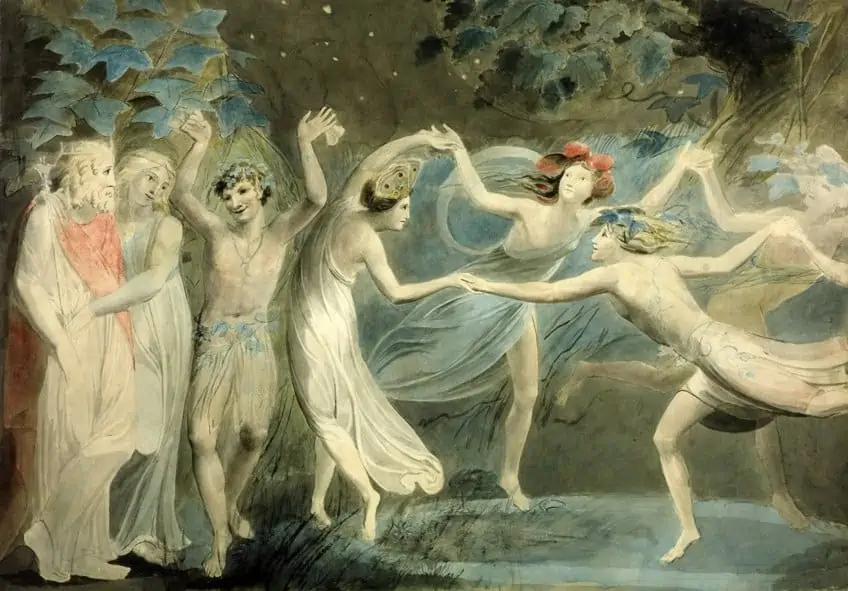
This dream-like painting is a scene imagined from the play, finished with excellence using watercolors and graphite. The end of the play states that the fairy king, Oberon, and the queen, Titania become friends again while the other fairies: Moth, Cobweb, Peaseblossom, and Mustardseed dance together in a ring. The addition of a tree trunk in the background adds to one’s interpretation of the fairies, that they are small beings as opposed to life-sized creatures, and gives one a glimpse into the land of the fairies while maintaining its fantasy quality.
The figures also appear to glow under the light of the fireflies, which only makes the fairies appear magical and is a traditional depiction of how one might imagine joyful, dainty fairies look.
Titania and Bottom (c. 1790) by Henri Fuseli
| Artist | Henry Fuseli (1741 – 1825) |
| Date | c. 1790 |
| Medium | Oil on canvas |
| Dimensions (cm) | 217.2 x 275.6 |
| Where It Is Housed | Tate Britain, London, England |
Titania and Bottom is another scene from Shakespeare’s A Midsummer Night’s Dream, which depicts a scene from Act IV featuring Titania under the influence of the love potion that her husband Oberon gave to her as a punishment. The effect of the potion caused Titania to fall in love with Nick Bottom, who bears the face of an ass.
The two are surrounded by other mythical beings of different sizes.
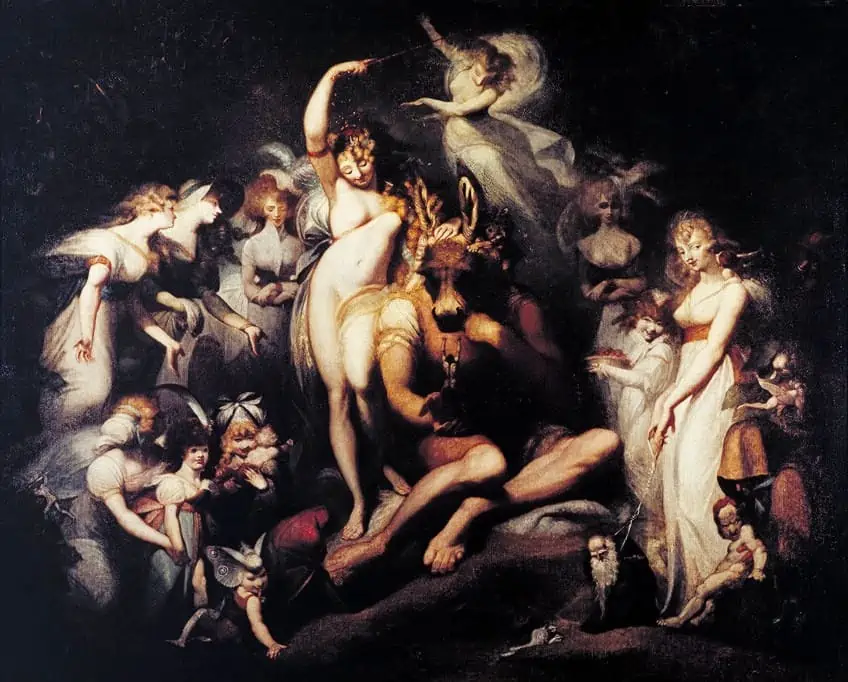
Another fairy can be seen petting Bottom’s head while another figure offers her assistance. From artificial children conjured up by witches on the left to the bizarre Nick Bottom character, this fairy painting is suggestive of many intriguing elements.
One such element is the theme of female domination seen in the woman holding an old man by a leash, which served as a reference to Girl Eating Oysters (c. 1658 – 1660) by Jan Steen.
The Fairy Lovers (c. 1840) by Theodor von Holst
| Artist | Theodor Richard Edward von Holst (1810 – 1844) |
| Date | c. 1840 |
| Medium | Oil on canvas |
| Dimensions (cm) | Support: 41.3 x 31.1, Frame: 53.7 x 43.7 x 8 |
| Where It Is Housed | Tate Gallery Collections, London, England |
This romantic fairy illustration is one of the most famous fairy paintings created by British painter, Theodor von Holst, who was deeply invested in subjects of the demonic and supernatural realms, which eventually fell out of favor with the public’s preference.
Von Holst drew inspiration from the literary talents of the time, including Mary Shelley, Dante Alighieri, Victor Hugo, and William Shakespeare.

Von Holst is also best known for being the first artist to illustrate the 1831 novel by Mary Shelley, Frankenstein. The Fairy Lovers portrays the two main characters from A Midsummer Night’s Dream, Oberon, and Titania, who are seen dancing under the partial light of the moon.
The duo are seen gently tip-toeing away into the moonlight in sync with each other and are dressed in flower head crowns and flowing garments.
Titania Sleeping (1841) by Richard Dadd
| Artist | Richard Dadd (1817 – 1886) |
| Date | 1841 |
| Medium | Oil on canvas |
| Dimensions (cm) | 59.6 x 77.4 |
| Where It Is Housed | The Louvre Museum, Paris, France |
With a love for the supernatural and all things mythical, Richard Dadd was a famous English painter who created some of the best paintings of fairies during the Victorian era. It can be said that Dadd was almost obsessed with the supernatural world of fairies, so much so that his paintings were rendered with incredible detail, it was as if he experienced the scenes firsthand.
The majority of his fairy paintings were created while he was still a patient at the Bethlehem and Broadmoor hospitals for murdering his father.
Was Dadd delusional or simply too invested in the supernatural? According to reports, Dadd murdered his father after being convinced that his father was the devil in disguise. After murdering his father with a knife, he fled to Paris and then attempted to kill a random stranger. It was then that Dadd was taken into police custody and then admitted to Bedlam in England.

Titania Sleeping shows the scene from Act II scene II of Shakespeare’s A Midsummer Night’s Dream where the fairies gently lull Titania to sleep. The painting was shown at the Royal Academy in 1841 alongside the quote “There sleeps Titania sometime of the night Lulled in these flowers with dances and delight”. The scene was also likened to the iconography associated with Christ’s nativity scene, which also contains multiple attendants catering to a single figure.
Titania Sleeping is a prime example of the heights to which many artists were inspired by Shakespeare and can be observed in the treatment of the narrative with the execution of the painting.
Dadd illuminates Titania and her attendants while creating a microcosmic environment with numerous cap mushrooms scattered on the landscape. Other famous fairy paintings by Dadd include The Fairy Feller’s Master-Stroke (1855 – 1864), which was also referenced by Freddie Mercury and Neil Gaiman.
The Captive Robin (c. 1864) by John Anster Fitzgerald
| Artist | John Anster Christian Fitzgerald (1819 – 1906) |
| Date | 1864 |
| Medium | Oil on canvas |
| Dimensions (cm) | Unavailable |
| Where It Is Housed | Unavailable |
The Captive Robin is a famous fairy painting by John Anster Fitzgerald whose works have been exhibited at various prominent institutions, including the Royal Academy of Arts and the British Institution. Fitzgerald’s works often draw reference to the darker world of fairies and feature creatures such as demons, ghouls, and other references to drug use.
Nicknamed “Fairy Fitzgerald”, the Victorian painter was compared to artists like Hieronymous Bosch for his surreal approach to painting that complemented the fairy fantasy of the 19th century.

The Captive Robin can be seen on the far right of the painting as it is held captive by a vine-like leash and surrounded by fairies and other mythical creatures observing the furry little prisoner. The fairy in the left corner grabs more attention with her ethereal blue attire and ornate headdress.
The robin was most likely captured as a gift to the fairies’ leader who is perhaps the fairy dressed in white being served refreshments.
Dancing Fairies (1866) by August Malmström
| Artist | Johan August Malmstöm (1829 – 1901) |
| Date | 1866 |
| Medium | Oil on canvas |
| Dimensions (cm) | 90 x 149 |
| Where It Is Housed | Nationalmuseum, Stockholm, Sweden |
This other-worldly painting of fairies under the moonlight transcends reality. The depiction of ethereal beings dancing over a lake almost seems ghostly and nightmarish yet its context, occurring in a realistic natural landscape, brings the realm of fairies closer to one’s perception of reality.
The duality of the painting was also cleverly emphasized in Malmstöm’s illustration of the fairies.

He chose to represent them as floating creatures that swiftly move over the water, like mist, and can be perceived as either mist in a romantic landscape or a reflection of Swedish folklore that cautioned people to watch out for elves in nature as they were associated with illness.
August Malmstöm was a famous Swedish painter who specialized in Norse and Swedish mythological subjects, as well as landscape and countryside paintings.
A Midsummer Night’s Dream (1873) by John Simmons
| Artist | John Simmons (1823 – 1876) |
| Date | 1873 |
| Medium | Watercolor on paper on canvas |
| Dimensions (cm) | 72.5 x 95.5 |
| Where It Is Housed | Private collection |
John Simmons was a miniature painter who specialized in portraiture and watercolor painting of enchanting fairytale scenes such as A Midsummer Night’s Dream. This watercolor painting is one of the most ethereal fair paintings of the 19th century and represents the height of the sensational genre at the time.
The painting illustrates the sleeping figures of Hermia and Titania executed with such a delicate approach to the resting female nude and a dream-like quality that accompanies the entire piece.
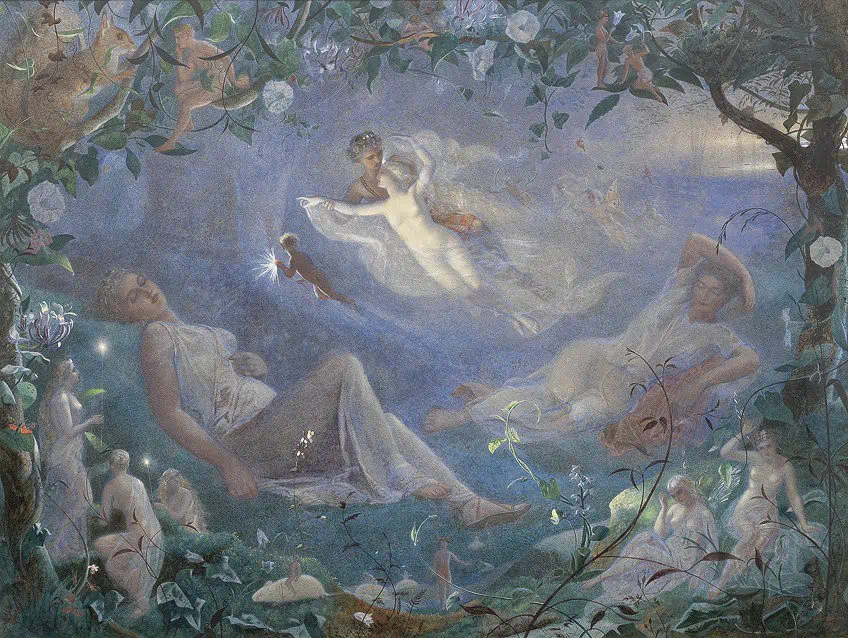
Simmons’ skillful representation of a fictional scene from Shakespeare’s play expertly highlights the fine boundaries between dreams and reality that Victorians used to escape from reality. Here, Titania serves as the epitome of female beauty and is presented with an exotic appeal that elevates the representation of the fairies as more than objects of desire, or perhaps, it amplifies it.
A Fairy Under Starry Skies (c. 1880) by Luis Ricardo Falero
| Artist | Luis Ricardo Falero (1851 – 1896) |
| Date | c. 1880 |
| Medium | Oil on canvas |
| Dimensions (cm) | 59 x 103 |
| Where It Is Housed | Private collection |
Luis Ricardo Falero was a Spanish artist who was so persistent in following his calling toward an art career that he abandoned a position in the navy and chose to walk to Paris, where he also explored engineering. After relocating to London, Falero spent a significant amount of time perfecting the human form and female nude through fairy illustrations, astronomical, and mythological subjects.
A Fairy Under Starry Skies was created around the 1880s when Falero began creating more fairy artworks.
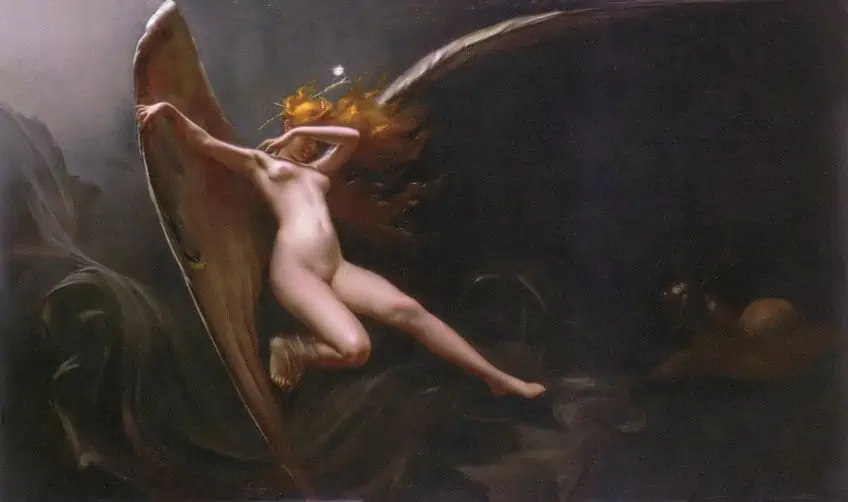
The painting shows a fairy painted in the nude descending from the starry sky above her. The figure appears to conceal her identity while she makes her landing and is positioned in such a way that her torso and most gentle features are exposed. Her auburn-colored hair also stands out as it blows in the wind from her descent.
Falero also uses the contrast of the shadow of the night and the luminescence of the moon to highlight the edges of the fairy’s wings, which make her appear angelic.
Die Waldfee (1894) by Karl Mediz
| Artist | Karl Mediz (1868 – 1945) |
| Date | 1894 |
| Medium | Oil on canvas |
| Dimensions (cm) | 164 x 169.5 |
| Where It Is Housed | Unavailable |
Die Waldfee, translated in English as the “Forest Fairy“, is an 1894 painting by Karl Mediz that is executed so beautifully that it reflects the later work of Gustav Klimt. Mediz was a famous Austrian painter whose works reflect the Symbolist style. Mediz’s forest fairy is presented as an elegant seated figure in her natural environment, the forest, dressed in a royal blue dress with a flower crown.
One of the most beautiful elements of the painting is the fairy’s dress, which showcases stunning floral motifs and is rendered so exquisitely that one can immediately identify the fabric as embroidered silk.
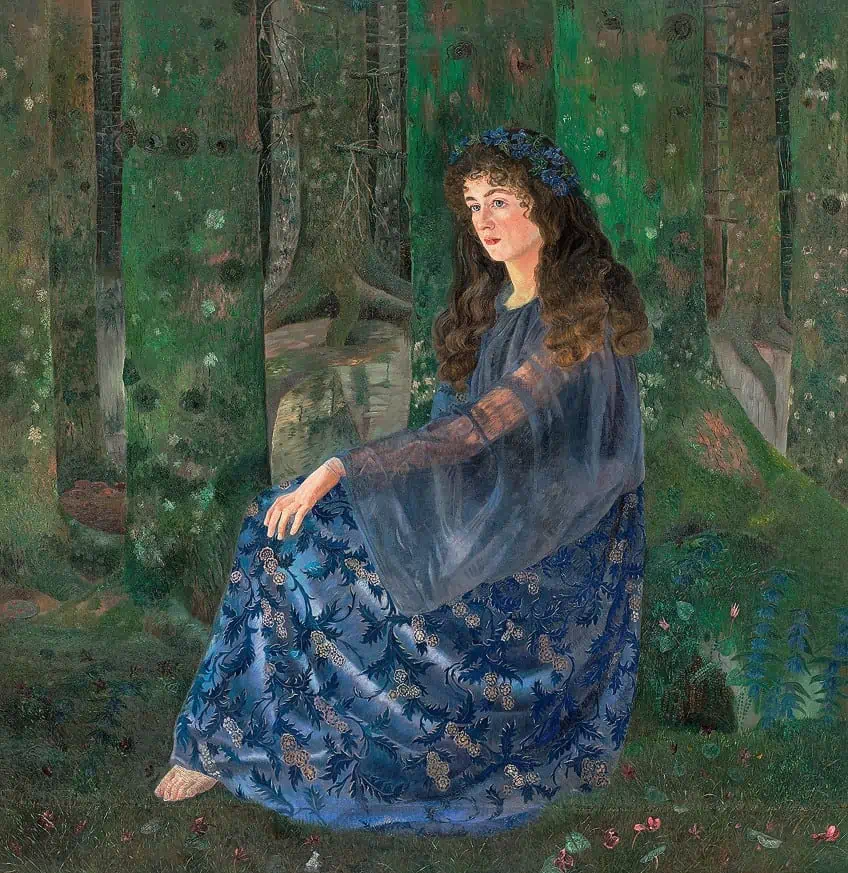
Mediz’s talent for texture is also seen in her sheer chiffon sleeve, which creases and folds naturally against her body. As a fairy, Mediz does not sexualize her body as seen in many other paintings of fairies, but he presents her as a figure to be admired as her entire body faces to the left, only exposing her bare foot, her face, and her hand while holding a calm demeanor. It is as if Mediz experienced a live fairy model in his reality such that the viewer might question if his experience was real.
Aside from the regal forest fairy, the moss that covers the forest trees is almost decorative and is an equally “pretty” background for its sitter.
Fairyland (1906) by Edward Reginald Frampton
| Artist | Edward Reginald Frampton (1870 – 1923) |
| Date | 1906 |
| Medium | Pencil and watercolor |
| Dimensions (cm) | 31.5 x 21.3 |
| Where It Is Housed | Unavailable |
Fairyland was created by Edward Reginald Frampton who was a late-19th-century painter who specialized in murals and war paintings. His style was influenced by French Symbolism, which was founded to represent or expose truths via symbolic or metaphorical means. Frampton’s style in Fairyland also reflects his interest in the art of stained glass.
Frampton’s mature art career led him to study the human form through large-figure painting, which was inspired by Sir Edward Burne-Jones.
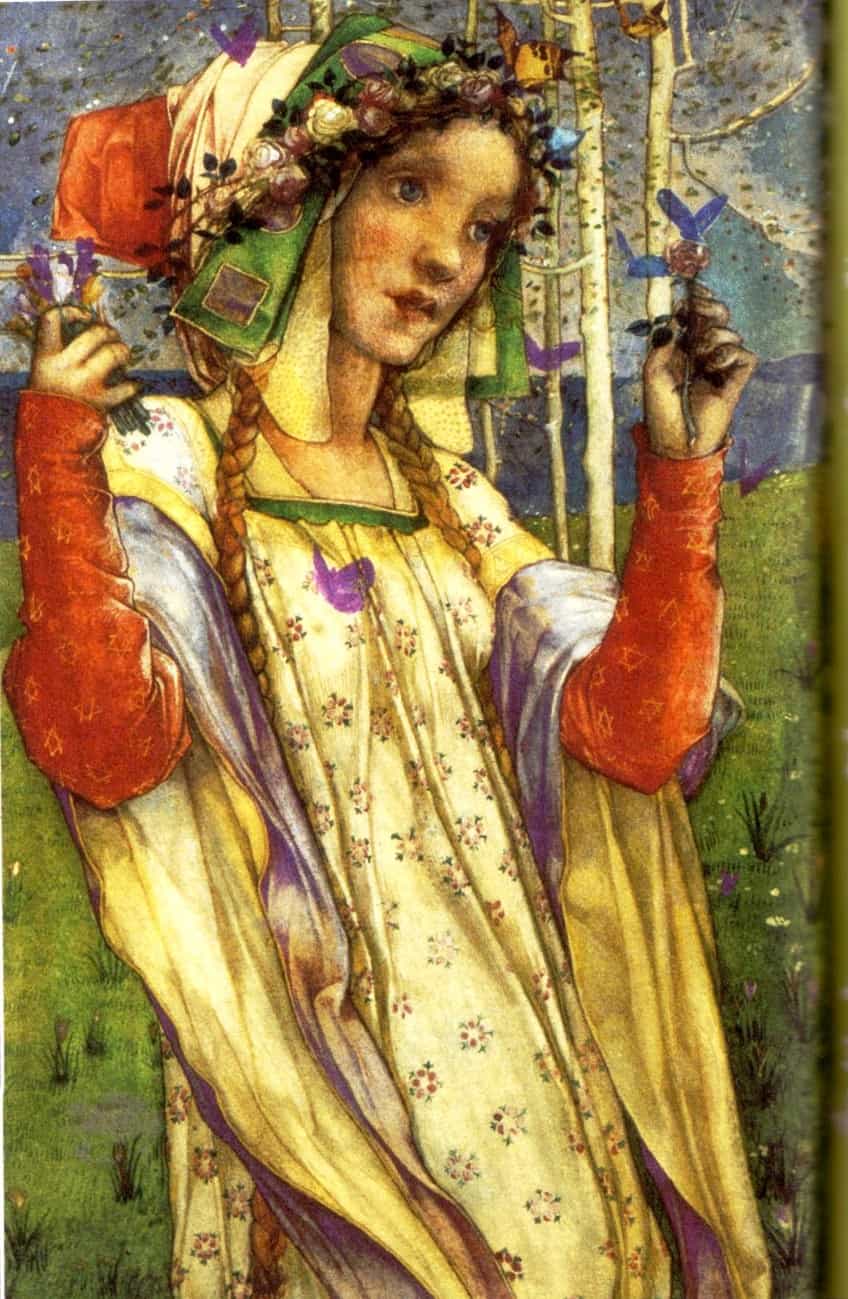
Fairyland illustrates a female fairy holding flowers in her hands as she gazes into the distance. This is perhaps one of the most direct references to the feeling of escapism as a coping mechanism and a dissociative state encouraged by the minute details of the scene.
The fairy seems lost in her own world, unaffected by the butterflies that land on her.
The Waterfall Fairy from The Enchanted Forest (1921) by Ida Rentoul Outhwaite
| Artist | Ida Rentoul Outhwaite or Ida Sherbourne Rentoul (1888 – 1960) |
| Date | 1921 |
| Medium | Watercolor |
| Dimensions (cm) | Unavailable |
The Waterfall Fairy is a famous fairy illustration by Australian illustrator, Ida Rentoul Outhwaite who was incredibly popular for her mythical illustrations. Her illustrations were featured in advertisements, newspapers, and around 22 publications between 1903 and 1958.
The Enchanted Forest was a publication issued in 1921 that featured around 31 beautiful fairy paintings such as The Waterfall Fairy, which presents this ethereal female being with hair as long as a waterfall in a vertically oriented landscape.

Flower Fairies of the Spring (1923) by Cicely Mary Barker
| Artist | Cicely Mary Barker (1895 – 1973) |
| Date | 1923 |
| Medium | Watercolor and pencil on paper |
| Dimensions (cm) | Varied |
Flower Fairies of the Spring was a 1923 book that featured multiple fairy illustrations by Cicely Mary Barker, a famous 20th-century illustrator, and watercolorist. Barker created various watercolor fairy paintings and sent her illustrations to multiple publishers in hope that someone would publish her work.
It was only two years after Flower Fairies of the Spring was published that Barker began receiving royalties on her work.
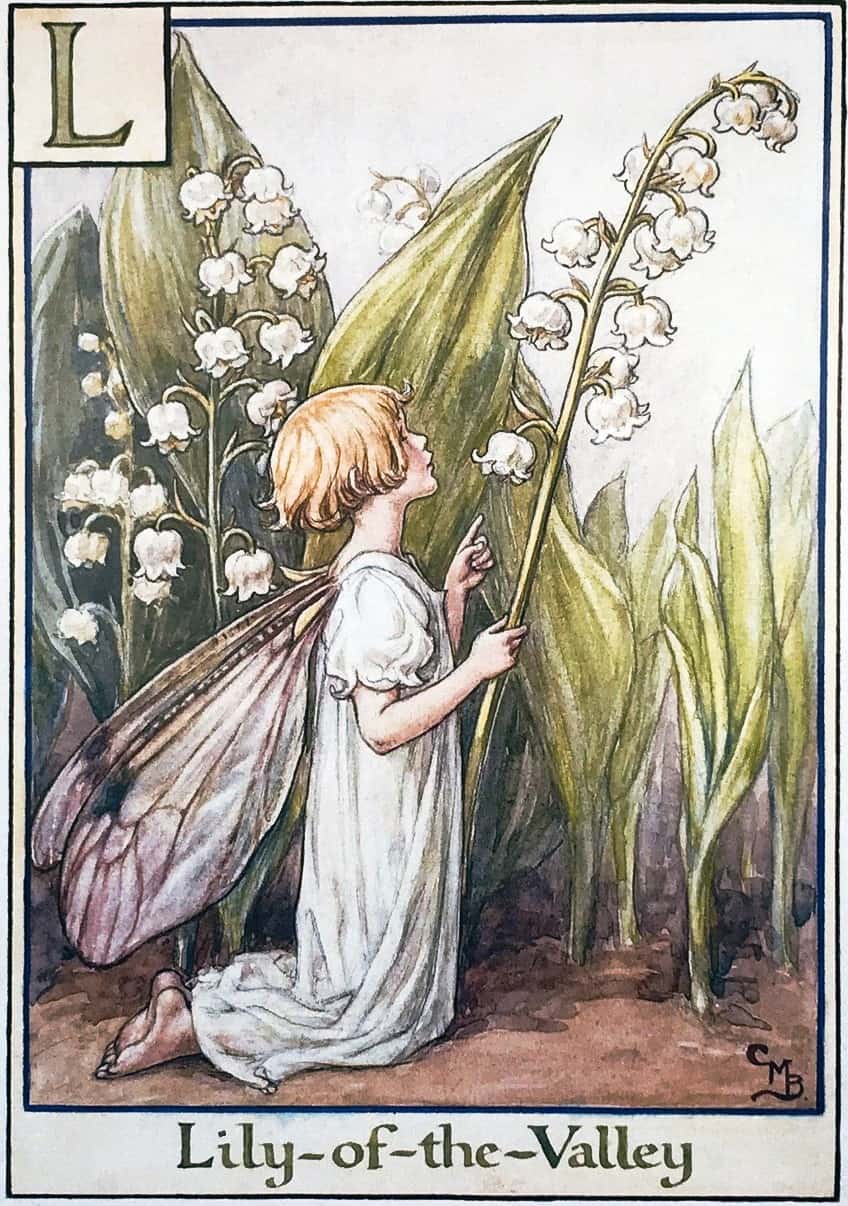
Barker’s passion for drawing and watercolor painting is evident in her fairy illustrations and was heavily influenced by the pre-Raphaelite movement. She remains one of the best-known English fantasy illustrators of the 20th century.
A Fairy and Elves Dusting Down the Coat of an Elder (c. 20th Century) by Margaret Winifred Tarrant
| Artist | Margaret Winifred Tarrant (1888 – 1959) |
| Date | c. 20th century |
| Medium | Watercolor |
| Dimensions (cm) | 21.5 x 155 |
| Where It Is Housed | Private collection |
Margaret Tarrant is among one of the most popular female fairy illustrators of the 20th century. She was most famous for her watercolor fairy paintings, as seen in A Fairy and Elves Dusting Down the Coat of an Elder. Tarrant started her art career at the young age of 20 and worked with publishers such as the Medici Society where she illustrated Christmas postcards, which became a hit.
A Fairy and Elves Dusting Down the Coat of an Elder showcases Tarrant’s gentle hand at watercolor illustrations as she paints the tiny mythical figures with joyful child-like expressions in keeping with the traditional image of fairies from fairy tales.
The 19th century saw different depictions of fairies, which reflected the growing anxiety and need for an escape among the public of the Victorian era. Major literary works like A Midsummer Night’s Dream (1595 – 1596) by William Shakespeare were coping mechanisms for people to escape into the fantastical land of fairies, elves, and animals while observing with an emotional distance, the dainty, other-worldly lives of fairies and their unique experiences that could only be dreamt of by the 19th-century citizen. The progression of fairy paintings seemed to coincide with a progression in the depiction of the female nude, which highlighted other issues of the time concerning the exoticism of the unreal alongside the ideal perception of beauty and a longing for it to break its way into reality.
Take a look at our most famous fairy paintings webstory here!
Frequently Asked Questions
What Is Fairy Painting?
Fairy painting, also called fairy art, refers to the genre of painting that emerged during the mid-19th century and was the preferred subject of entertainment and artistic preference for many people in Victorian England. Fairy painting contains scenes of fairies and supernatural creatures with sub-themes of the female nude, the male gaze, beauty, romance, celebration, exoticism, and other themes that blur and connect the lines between mythology and reality.
Who Is the Most Famous Victorian Fairy Artist?
The most famous Victorian fairy artist is considered to be Richard Dadd. He was incredibly popular for his detailed Victorian fairy paintings, which provided comfort for the British public during a period of immense social and technological change.
Did Victorians Believe That Fairies Were Real?
While many people were aware that fairies were a work of the imagination drawn from fictional stories, others formed cults and groups that upheld the belief in the existence of fairies, also called Sylphs. These cults believed that such creatures existed everywhere and were biologically visceral so that humans could not see them.
Jordan Anthony is a Cape Town-based film photographer, curator, and arts writer. She holds a Bachelor of Art in Fine Arts from the University of the Witwatersrand, Johannesburg, where she explored themes like healing, identity, dreams, and intuitive creation in her Contemporary art practice. Jordan has collaborated with various local art institutions, including the KZNSA Gallery in Durban, the Turbine Art Fair, and the Wits Art Museum. Her photography focuses on abstract color manipulations, portraiture, candid shots, and urban landscapes. She’s intrigued by philosophy, memory, and esotericism, drawing inspiration from Surrealism, Fluxus, and ancient civilizations, as well as childhood influences and found objects. Jordan is working for artfilemagazine since 2022 and writes blog posts about art history and photography.
Learn more about Jordan Anthony and about us.
Cite this Article
Jordan, Anthony, “Famous Fairy Paintings – Looking at Magical Paintings of Fairies.” artfilemagazine – Your Online Art Source. December 15, 2022. URL: https://artfilemagazine.com/famous-fairy-paintings/
Anthony, J. (2022, 15 December). Famous Fairy Paintings – Looking at Magical Paintings of Fairies. artfilemagazine – Your Online Art Source. https://artfilemagazine.com/famous-fairy-paintings/
Anthony, Jordan. “Famous Fairy Paintings – Looking at Magical Paintings of Fairies.” artfilemagazine – Your Online Art Source, December 15, 2022. https://artfilemagazine.com/famous-fairy-paintings/.



